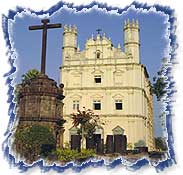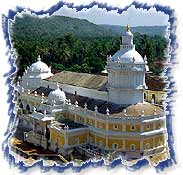Goa - City of Beaches

Area : : 29 sq km
Population : 4,02,700(approx.)
Picture yourself on a beautiful Beach with silver sand to swim and surf,
white Churches surrounded by green paddy fields and coconut groves, going
for a long stroll on a starry night, and somewhere someone is playing a
romantic tune on his guitar. That’s Goa for you
The various places to visit are :
Anjuna Beach, Aguda Fort, Calingute Beach, St Cathedral Church of St.
Francis, Bom Jesus Basilica, Dudhsagar Waterfalls, Carambolin Lake.
It is a blend of the east and west, with Christmas and Carnival are
celebrated as enthusiastically as Diwali and Durga Puja. In its Latin
architecture there is also a preference of a fish-meat cuisine. The
prevalence of cheap beer blends perfectly well with the traditional tipples
of Feni, the local hooch and toddy.
Panaji still looks and feels like any Portuguese town with grand public
buildings and old houses with over Hanging balconies and numerous bars &
cafes.
Tourism is the main money-spinner business in Goa. But on the coast,
coconut cultivation and fishing are still the main sources of income.
Tourism happens all over the year but if you want to enjoy the Carnival
better visit in Feb-March.
Carnival in Goa :

Carnival
in Goa is a non-stop 3-day festival of color, song and music, providing a
healthy entertainment for all, young and old. The soothing climate, full of
fun- 'n' -frolic, which the Carnival generates, is much longed for. It does
not matter whether one enjoys or see others enjoying. There is enthusiasm
and happiness all around.
The word 'carnival' is said to be derived from the Latin 'Carne', meaning
meat, and 'Vale', which translates to 'good-bye'. Some also link the word to
'Carnislevamen' or 'the pleasures of meat', focusing on the enjoyment of
meat during the festivities, before the abstinence that follows during Lent.
Another hypothesis suggests that the word came from 'Carrus Navalis', the
horse-drawn, boat-shaped carriage that was paraded during the Roman festival
Saturnalia, in honor of Saturn. It carried men and women in fancy dresses,
wearing masks, and singing obscene songs. It is possible that the
present-day concept of a carnival emerged from this parade.
Originination Of The Festivity :
The Goa Carnival is an integral part of the Portuguese heritage of the
state, which was a dominion of Portugal till 1961. The carnival epitomizes
the fun-loving culture that is characteristic of Goa. It was introduced by
the erstwhile rulers as a rowdy celebration in which flour, eggs, oranges,
lemons, mud, sand-filled gloves along with dirty water, various liquids and
glue were aimed at passersby. Used pots, pans, and other kitchen utensils
were also thrown out of windows. Perhaps this was done to discard the old
and the dirty before the Lenten fast.
 |
|
 |
Fierce battles were waged in the streets, with plaster-of-Paris
eggs, wax lemons, corncobs and beans. Blows were dealt out liberally, with
brooms and wooden spoons. It was also an occasion for unchecked eating.
People gorged on rich food at lavish feasts, and convents distributed cakes
and pastries. Though celebrated for only three days, the preparations for
the festival would take many days, and build up to a frenetic pitch by the
eve of the carnival. The carnival in Goa still retains the core of the
original. A King of Chaos is elected, called King "Momo". He
presides over the three-day festivities, which attract visitors from all
over India and abroad.
A Musical Extravaganza :

Street
Plays, songs, dances, and unrehearsed farces mocking the establishment are
performed before an enthusiastic, responsive audience. Floats depicting
popular lullabies and nursery rhymes make a whimsical and colorful sight on
the streets. In the three days of celebrations, cultural functions and
competitions abound, and are judged by specially selected people. King Momo
distributes the prizes to the winners.
The contestants wear colorful costumes and elaborate masks. Amidst the
outrageous dresses seen on the street are some made of sheer, transparent
polythene. In the fun-filled ambience, people smear color on each other,
instead of the flour, eggs, fruit and water that used to be used in earlier
times.



 Carnival
in Goa is a non-stop 3-day festival of color, song and music, providing a
healthy entertainment for all, young and old. The soothing climate, full of
fun- 'n' -frolic, which the Carnival generates, is much longed for. It does
not matter whether one enjoys or see others enjoying. There is enthusiasm
and happiness all around.
Carnival
in Goa is a non-stop 3-day festival of color, song and music, providing a
healthy entertainment for all, young and old. The soothing climate, full of
fun- 'n' -frolic, which the Carnival generates, is much longed for. It does
not matter whether one enjoys or see others enjoying. There is enthusiasm
and happiness all around.  Street
Plays, songs, dances, and unrehearsed farces mocking the establishment are
performed before an enthusiastic, responsive audience. Floats depicting
popular lullabies and nursery rhymes make a whimsical and colorful sight on
the streets. In the three days of celebrations, cultural functions and
competitions abound, and are judged by specially selected people. King Momo
distributes the prizes to the winners.
Street
Plays, songs, dances, and unrehearsed farces mocking the establishment are
performed before an enthusiastic, responsive audience. Floats depicting
popular lullabies and nursery rhymes make a whimsical and colorful sight on
the streets. In the three days of celebrations, cultural functions and
competitions abound, and are judged by specially selected people. King Momo
distributes the prizes to the winners. 